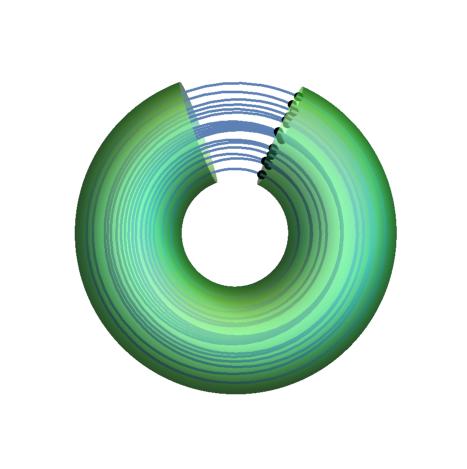What we have learned (in SU(1,1) decomposition) about the structure of the group SU(1,1) so far? In SU(1,1) decomposition we have learned that every matrix ![]() from SU(1,1), being of the form
from SU(1,1), being of the form
(1) ![]()
can be uniquely represented as a product
(2) ![]()
where ![]() is positive matrix, and
is positive matrix, and ![]() is a unitary matrix. We have
is a unitary matrix. We have
(3) ![]()
and
(4) 
(5) ![]()
with ![]() and
and ![]() The unit disk
The unit disk ![]()
(6) ![]()
is the cross section of the donut, the angle ![]() goes around the donut.
goes around the donut.
Today we will look at the orbits produced inside the donut by the action of the unitary group.

Notice that matrices ![]() form a group – a one-parameter subgroup of SU(1,1):
form a group – a one-parameter subgroup of SU(1,1):
(7) ![]()
This group is usually denoted U(1). Strictly speaking U(1) is the group of complex numbers of modulus 1, that is complex numbers of the form ![]() Our group has two such complex numbers on the diagonal,
Our group has two such complex numbers on the diagonal, ![]() and its complex conjugate
and its complex conjugate ![]() but it is isomorphic to U(1) – it is essentially the same group. If you have one dollar, and its reflection in a mirror – you do not have two dollars. If you spend one, the reflection is also spent…. Perhaps it is not a very good example…. What if you spend the reflection to save the real buck?
but it is isomorphic to U(1) – it is essentially the same group. If you have one dollar, and its reflection in a mirror – you do not have two dollars. If you spend one, the reflection is also spent…. Perhaps it is not a very good example…. What if you spend the reflection to save the real buck?
So, what are these orbits? We are interested in orbits produced by action of matrices ![]() from the right. So let us take some element
from the right. So let us take some element ![]() from the group. We are going to act on this element with matrices
from the group. We are going to act on this element with matrices ![]() from the right. In order to avoid confusion, we will use
from the right. In order to avoid confusion, we will use ![]() instead of
instead of ![]() as the argument of the matrices tah act on
as the argument of the matrices tah act on ![]() . So, we multiply
. So, we multiply ![]() by
by ![]() from the right. We get
from the right. We get
![]()
Therefore the parameter ![]() is constant along the orbit. Only parameter
is constant along the orbit. Only parameter ![]() is changing. That is, we move around the donut, keeping the position on cross sections fixed. To know the orbit it is enough to know the point of its intersection with one fixed cross-section. Here is the plot of several such orbits:
is changing. That is, we move around the donut, keeping the position on cross sections fixed. To know the orbit it is enough to know the point of its intersection with one fixed cross-section. Here is the plot of several such orbits:


On the images it may look as if orbits can intersect, but this is only because of perspective. Two orbits either coincide, or they are disjoint, they do not have common points.
I took out a piece of our donut only for us to see better what is inside. The group is the whole donut, and orbits go inside.
So, to different orbits there correspond different complex numbers ![]() . Give me one
. Give me one ![]() inside the disk, and I will give you the orbit. So, I have made the points of intersection of orbits with one cross-section, namely the one for
inside the disk, and I will give you the orbit. So, I have made the points of intersection of orbits with one cross-section, namely the one for ![]() somewhat bigger. Each such point determines an orbit.
somewhat bigger. Each such point determines an orbit.
The inside of the unit disk can be considered as the space of orbits.
We can look at these orbits in a somewhat different way, as follows. To each matrix ![]()
![]() we associate
we associate ![]() Let us give some name to this association, let’s call it
Let us give some name to this association, let’s call it ![]()
(8) ![]()
Then, for every ![]() we have
we have ![]() Two points on the same orbits map into the same
Two points on the same orbits map into the same ![]()
Let us see that it is indeed so. Let ![]() Let
Let ![]() . Then
. Then
![]()
Therefore ![]()
![]()
![]() , and so
, and so ![]()
What about orbits from the left action? We will look at the next post.





Thx!